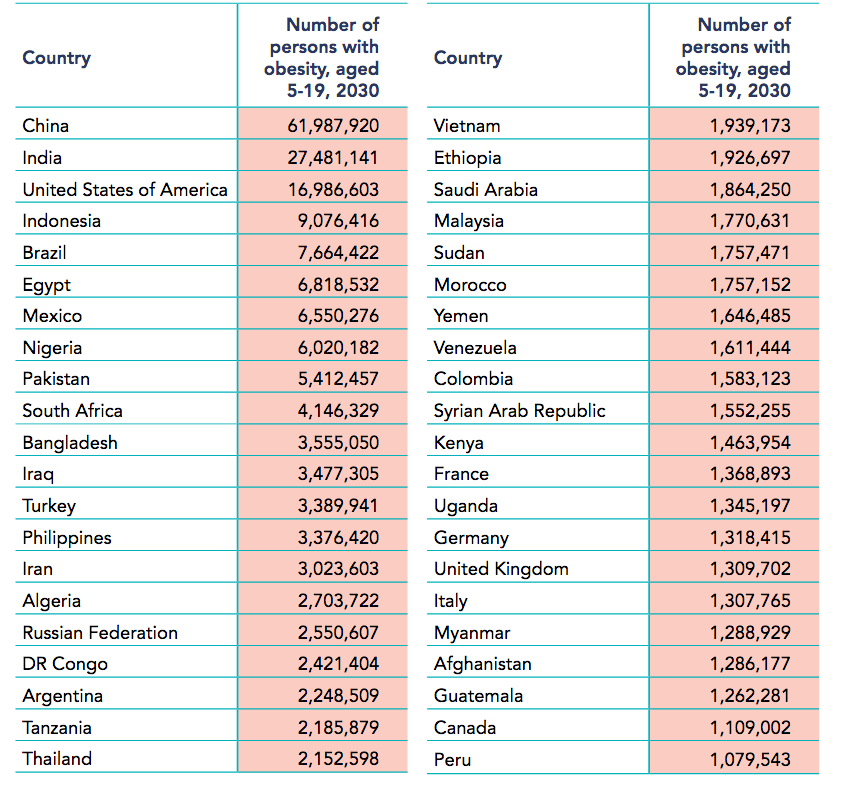
Published by the World Obesity Federation (WOF), the atlas, which compares 196 countries, predicts that by 2030, 12 per cent (490,205) of children aged five to nine will be obese and 10 per cent (819,496) of 10-to- 19-year-olds.
This compares to the latest findings from the National Child Measurement Programme, which found that 9.5 per cent of Reception children are obese and 20 per cent of 10- to 11-year-olds.
The atlas predicts that more than 1.3 million children and young people in the UK will be obese in 11 years’ time.
The predictions are determined using current statistics on each country’s maternal obesity rates, maternal smoking, breastfeeding rates and impaired growth and development in infancy, to calculate a ‘risk score’ for their likelihood of having or acquiring major childhood obesity problems.
The UK is one of 42 countries where over one million school-age children and young people are predicted by WOF to be living with obesity in 2030 (see below table). Some of the other countries are – Thailand, France and South Africa.
China is predicted to have the largest number of children and teenagers living with obesity in 11 years’ time (61,987,920), followed by India (27,481,141) the United States (16,986,603) and Indonesia (9,076,416).
Countries predicted to have over one million children living with obesity in 2030

Worldwide it predicts that 206 million five-19-year-olds will be obese by 2025, rising to 254 million in 2030.
The Cook Islands is thought to be most at risk of having or acquiring a ‘significant’ childhood obesity problem in the coming decade, while Zambia has the lowest risk.
The atlas shows that no country has a better than 50 per cent chance of meeting their target for tackling childhood obesity. The World Health Assembly agreed in 2013 that countries should ensure their levels of childhood obesity are no higher in 2025 than they were in 2010-2012.
It finds that the UK has a 39 per cent chance of meeting the target.
A total of eight out of ten countries (156) have less than a 10 per cent chance of meeting their target.
The WOF argued that despite repeated governments’ commitments to addressing childhood obesity, there has been little progress made in some place and actions to back up commitments have been weak. It says, for instance, 70 per cent of countries still fail to have policies in place to restrict marketing to children.
Comments
Dr Tim Lobstein, director of policy at the WOF and one of the authors of the report, said that the ‘dramatic rise in the numbers of children affected by obesity is being driven by emerging economies – in Asia, the Middle East and Latin America.
Professor Donna Ryan, WOF president, added, ‘Obesity in childhood is closely associated with obesity in adulthood, and with more years living with obesity, both of which are linked to a high level of consequential disease. This means that without substantial interventions to prevent and to treat childhood obesity, the problem will overwhelm the health services of many countries.’
WOF chief executive officer, Johanna Ralston, said, ‘This atlas puts down a marker against which countries must take action.
‘Just like the climate crisis, we are witnessing a critical failure of governments to respect and protect our children’s rights to good health now and into the future. Both global heating and childhood obesity are suffering from a lack of government leadership, and a hostile commercial environment resisting change. We know we can do better, and we must.’
Government response
A Department of Health and Social Care spokesperson said, 'We want to make it as easy as possible for families to make healthier choices as part of our plans to halve childhood obesity by 2030.
'Through our world-leading childhood obesity plans, we are reducing children's exposure to sugary and fatty foods, getting them moving more in schools and funding councils to find innovative local solutions.'









